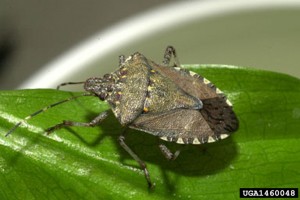When I sit at my writing desk I spend as much time as possible looking out the window at the ongoing events in my backyard. A few days ago my view of a blue jay digging around in my compost pile (he was looking for, finding and eating fragments of egg shells!) was interrupted by the arrival of an organism that I haven’t seen since the end of June: the brown marmorated stink bug (which is frequently referred to as “BSMB”)!
One of these exotic invasive stink bugs attached itself onto the outside of my window screen and was walking around in a tight circle. When I looked back up a minute or so later, there were seven of them slow dancing around each other. They have been increasing in numbers ever since.
These stink bugs have spent the summer out in the surrounding vegetation (especially in my grape vines and apple trees, I am sure). They are the progeny of those stink bugs that survived their winter hibernations and managed to mate this past spring. Each mated female could have laid three hundred eggs which would have quickly hatched into the first of five immature, instar stages. These growing immature stink bugs spent the next two months feeding and growing and hiding out in the vegetation until they molted into their adult forms. They then started to look for a safe place to spend the upcoming winter.
Bill O’Hara (Dee’s husband) caught thousands of adult BMSB’s last fall. He used one liter, plastic, screw-top bottles with some soap solution in the bottom and took advantage of the typical escape behavior of the stink bug (they drop straight down when disturbed!) to induce them to fall into the bottle and the killing soap. Deborah and I had tried to be tolerant of the BMSB’s but their numbers finally overwhelmed even our ecological sensibilities. We used the “O’Hara method” this past spring as thousands of stink bugs emerged from their winter hibernaculae inside and around our house. We filled up several bottles a week with dead and dying stink bugs. When we had house guests we gave everyone their own stink bug bottle so that they could contribute to the correction of this exotic species invasion! We were the perfect hosts!
As I mentioned last year, the brown, marmorated stink bug (scientific name: Halyomorpha halys) is a relatively new sign of fall here in Western Pennsylvania. It is a native of northeast Asia (Japan, Korea, and China) and, apparently, is just as annoying there as it is here! Its use of human habitations as hibernation refuges, and its ability to communicate via pheromones and then aggregate in great numbers in some selected house, barn, porch, garage, or any other stink-bug-determined-suitable building makes their presence both in their native and also in their invasive regions impossible to ignore.
It is thought that this insect was first released into the United States in Allentown, PA in 1996. It apparently traveled from northeast Asia in a shipping container that was delivered either to the port of Philadelphia or Elizabeth, New Jersey and then trucked to Allentown. Five years later this new, alien, invasive species was recognized and identified by entomologists at Cornell University, but by then large populations were established throughout eastern Pennsylvania, New Jersey and New York. This insect has now spread to thirty-five states primarily in the eastern United States. It has very large populations in Pennsylvania, Maryland, Virginia, New York, New Jersey, Massachusetts, Delaware, Ohio, and North and South Carolina. It has also spread to California and Oregon allegedly in a car driven by a person traveling from Pennsylvania to California in 2005.
Here in Western Pennsylvania our first, massive fall outbreak of brown marmorated stink bugs was in 2010. Two of my students since then have gotten interested in the species and have done some research into their biology and ecology and even conducted some experiments to determine the species’ habitat selection preferences. I had hoped that their research would result in an effective stink bug trap, but we’re still working on that!
There is a consortium of university and government researchers who are looking into the basic ecology and biology of the brown marmorated stink bug. Their goal is to come up with effective control measures to stem this growing biological invasion. The group (called “Stop BMSB”) is funded by the US Dept. of Agriculture and includes fifty researchers from ten universities (including Penn State!). They are even conducting a “citizen’s science” survey this fall to try to determine some of the ecological and behavioral features of this bug. Their “2014 Great Stink Bug Count” asks homeowners to go out around their houses every day to determine the numbers and locations of any stink bugs that are present. If you are interested in participating, the URL for the group is www.stopbmsb.org. Maybe they can figure out what that better stink bug trap should be!
So far, the stink bugs are only on the outside of the house, but they will start to slip in soon. We are saving up screw top bottles. Drop by anytime for a lesson in the O’Hara technique!


